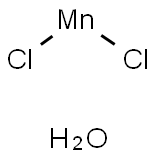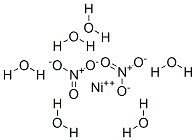MANGANESE(II) CHLORIDE HYDRATE
Synonym(s):Manganese dichloride monohydrate
- CAS NO.:64333-01-3
- Empirical Formula: Cl2H2MnO
- Molecular Weight: 143.86
- MDL number: MFCD00149793
- EINECS: 613-575-3
- SAFETY DATA SHEET (SDS)
- Update Date: 2023-04-23 13:52:06

What is MANGANESE(II) CHLORIDE HYDRATE?
The Uses of MANGANESE(II) CHLORIDE HYDRATE
Starting material for preparation of organomanganese chloride reagents; in combination with RLi or RMgX catalyzes reduction of vinyl and aryl halides, stereoselective coupling of vinyl iodides, and alkylation of enol triflates; also used for Mn-Cu-catalyzed conjugate addition of RMgX to enones and for Mn-catalyzed acylation of RMgX by acyl chlorides; in combination with NaBH4 is diastereoselective reducing agent; starting material for the preparation of Mn enolates regio- andstereo-selectively.
What are the applications of Application
Manganese(II) chloride monohydrate is a material to initiate preparation of organomanganese chloride reagents
Properties of MANGANESE(II) CHLORIDE HYDRATE
| Melting point: | 122 °C(lit.) |
| Density | 1.913 g/mL at 25 °C(lit.) |
| storage temp. | Hygroscopic, Room Temperature, under inert atmosphere |
| solubility | Methanol (Slightly), Water (Slightly) |
| form | Solid |
| color | Pale Pink to Light Red |
Safety information for MANGANESE(II) CHLORIDE HYDRATE
| Signal word | Danger |
| Pictogram(s) |
 Corrosion Corrosives GHS05  Skull and Crossbones Acute Toxicity GHS06  Health Hazard GHS08  Environment GHS09 |
| GHS Hazard Statements |
H301:Acute toxicity,oral H318:Serious eye damage/eye irritation H373:Specific target organ toxicity, repeated exposure H411:Hazardous to the aquatic environment, long-term hazard |
| Precautionary Statement Codes |
P260:Do not breathe dust/fume/gas/mist/vapours/spray. P273:Avoid release to the environment. P280:Wear protective gloves/protective clothing/eye protection/face protection. P314:Get medical advice/attention if you feel unwell. P301+P310:IF SWALLOWED: Immediately call a POISON CENTER or doctor/physician. P305+P351+P338:IF IN EYES: Rinse cautiously with water for several minutes. Remove contact lenses, if present and easy to do. Continuerinsing. |
Computed Descriptors for MANGANESE(II) CHLORIDE HYDRATE
MANGANESE(II) CHLORIDE HYDRATE manufacturer
Nandu Chemical Industries
1Y
Phone:+91-8362330469
Whatsapp: +91 8362330469
product: 64333-01-3 Manganese dichloride monohydrate 99%
New Products
Tert-butyl bis(2-chloroethyl)carbamate (S)-3-Aminobutanenitrile hydrochloride N-Boc-D-alaninol N-BOC-D/L-ALANINOL N-octanoyl benzotriazole 4-Hydrazinobenzoic acid 3,4-Dibenzyloxybenzaldehyde 1,1’-CARBONYLDIIMIDAZOLE R-2-BENZYLOXY PROPIONIC ACID 1,1’-CARBONYLDI (1,2-4 TRIAZOLE) 4-HYDROXY BENZYL ALCOHOL 3-NITRO-2-METHYL ANILINE (2-Hydroxyphenyl)acetonitrile 4-Bromopyrazole 5-BROMO-2CYANO PYRIDINE 5,6-Dimethoxyindanone 5-broMo-2-chloro-N-cyclopentylpyriMidin-4-aMine 4-methoxy-3,5-dinitropyridine 2-(Cyanocyclohexyl)acetic acid 2-aminopropyl benzoate hydrochloride 1-(4-(aminomethyl)benzyl)urea hydrochloride tert-butyl 4- (ureidomethyl)benzylcarbamate diethyl 2-(2-((tertbutoxycarbonyl)amino) ethyl)malonate Ethyl-2-chloro((4-methoxyphenyl)hydrazono)acetateRelated products of tetrahydrofuran








You may like
-
 64333-01-3 Manganese dichloride monohydrate 99%View Details
64333-01-3 Manganese dichloride monohydrate 99%View Details
64333-01-3 -
 Manganese(II) chloride monohydrate CAS 64333-01-3View Details
Manganese(II) chloride monohydrate CAS 64333-01-3View Details
64333-01-3 -
 55441-95-7 99%View Details
55441-95-7 99%View Details
55441-95-7 -
 N-Vinylformamide 99%View Details
N-Vinylformamide 99%View Details
13162-05-5 -
 Chloro Uracil 1820-81-1 99%View Details
Chloro Uracil 1820-81-1 99%View Details
1820-81-1 -
 2-ethyl-6-methyl-3-hydroxypyridine succinate 99%View Details
2-ethyl-6-methyl-3-hydroxypyridine succinate 99%View Details
127464-43-1 -
 2-ETHYLPYRIDINE 100-71-0 99%View Details
2-ETHYLPYRIDINE 100-71-0 99%View Details
100-71-0 -
 181228-33-1 (S)-Methyl 3-amino-2-((tert-butoxycarbonyl)amino)propanote Hydrochloride (DAP-OMe. HCl) 99%View Details
181228-33-1 (S)-Methyl 3-amino-2-((tert-butoxycarbonyl)amino)propanote Hydrochloride (DAP-OMe. HCl) 99%View Details
181228-33-1
Statement: All products displayed on this website are only used for non medical purposes such as industrial applications or scientific research, and cannot be used for clinical diagnosis or treatment of humans or animals. They are not medicinal or edible.